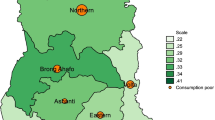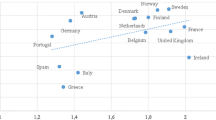Abstract
This paper uses longitudinal data from the Philippines to analyze determinants of children’s time allocation. The estimation method takes into account both the simultaneity of time use decisions, by allowing for correlation of residuals across time uses, and unobservable family heterogeneity, through the inclusion of household fixed effects. Importantly, this improved estimation method leads to different results than when applying the methods previously used in the literature. Girls suffer significantly from the absence of their mother with a reduction in time spent in school that is equivalent to dropping out completely. This effect is substantially larger when controlling for household unobservables than when not. Boys increase time spent working on market related activities in response to an absent father, although this time appears to come out of leisure rather than school or doing household chores. Land ownership substantially increase the time boys spend on school activities, whereas renting land reduces the time girls spend on school. Finally, there does not appear to be a substantial trade-off between time spent on school and work, either in the market or at home.
Similar content being viewed by others
Notes
An example is hard or hazardous work that may have damaging effects on children’s health that are only seen later in life. The improper use of pesticides may, for example, have serious adverse health effects that only emerge following a long time lag. Another example is the human capital accumulation of the child, which is a strong predictor of lifetime income.
Unfortunately, the 1975 survey round is unavailable and time allocation data were not collected for the 1998 resurvey.
Another important longitudinal data set from the Philippines is the Cebu survey. The focus of the Cebu survey is, however, on the index child and there is therefore only limited information about siblings. The 1994 follow-up survey did ask about the index child and a younger siblings’ time allocation, but those questions were not longitudinal. Furthermore, they did not ask for a specific recall of time, but a statement of hours spent on a set of specific activities during a “regular” day.
This under-reporting of productive activities of children also seemed to be an issue in the related surveys conducted in the Bicol area of the Philippines (personal correspondence with John Maluccio).
An example of child level heterogeneity is the learning ability of a child. A child better suited for receiving schooling might spend more time in school than a child with the same (observable) characteristics but lower ability.
The program can be downloaded at http://www.applied-ml.com/.
A similar results is seen in India (Kis-Katos 2012).
See, for example, Beegle et al. (2009) for an example from Vietnam, where the increased experience in the labor market outweighs the reduced time in school.
Fostering is less prevalent in the Philippines than other places, so we are not picking up children from other households where we know that their parents have died. For a discussion of the effect of parental death in circumstances where fostering is prevalent see, for example, Ainsworth (1996), Zimmerman (2003), Akresh (2007), and Coneus et al. (2012).
One caveat is that the estimated correlations are potentially biased downward if one or more time uses are at 0. If, say, time spent in school is already at 0, then increasing time spent working obviously cannot decrease time in school any further. As shown in Tables 2, 3, this is mainly an issue for very young children where few participate in market activities.
One of the few papers to examine this questions is Ravallion and Wodon (2000), who for Bangladesh show that child labor does not displace schooling completely. The results here indicate that this result holds even when controlling for unobserved household characteristics.
References
Ainsworth, M. (1996). Economic aspects of child fostering in Cote D’Ivoire. In T. P. Schultz (Ed.), Research in population economics, Vol. 8 (pp. 25–62). Greenwich, CT: JAI Press Inc.
Ainsworth, M., Beegle, K., & Koda, G. (2005). The impact of adult mortality and parental deaths on primary schooling in North-Western Tanzania. Journal of Development Studies, 41(3), 412–439.
Akabayashi, H., & Psacharopoulos, G. (1999). The tradeoff between child labour and human capital formation: A Tanzanian case study. Journal of Development Studies, 35(5), 120–140.
Akresh, R. (2007). School Enrollment Impacts of Non-traditional Household Structure. Mimeo: University of Illinois at Urbana-Champaign.
Arends-Kuenning, M., & Amin, S. (2004). School incentive programs and children’s activities: The case of Bangladesh. Comparative Education Review, 48(3), 295–317.
Assaad, R., Levison, D., & Zibani, N. (2010). The effect of domestic work on girls’ schooling: Evidence from Egypt. Feminist Economics, 16(1), 79–128.
Beegle, K., Dehejia, R., & Gatti, R. (2009). Why should we care about child labor? The education, labor market, and health consequences of child labor. Journal of Human Resources, 44(4), 871–889.
Boozer, M. A., & Suri, T. K. (2001). Child labor and schooling decisions in Ghana. Working paper, Yale University, New Haven, CT.
Cardoso, E., & Souza, A. P. (2004). The impact of cash transfers on child labor and school attendance in Brazil. Working paper No. 04–W07, Vanderbilt University, Nashville, TN.
Coneus, K., Mühlenweg, A. M., & Stichnoth, H. (2012). Orphans at risk in sub-Saharan Africa: Evidence on educational and health outcomes. Review of Economics of the Household. doi:10.1007/s11150-012-9167-4.
de Hoop, J., & Rosati, F. C. (2012). Does promoting school attendance reduce child labour? Evidence from Burkina Faso’s BRIGHT Project. Discussion Paper Series IZA DP No. 6601, IZA, Bonn, Germany.
Dumas, C. (2012). Does work impede child learning? The case of Senegal. Economic Development and Cultural Change, 60(4), 773–793.
Edmonds, E. V. (2008). Child labor. In T. P. Schultz & J. A. Strauss (Eds.), Handbook of development economics, Vol. 4, Chap. 57 (pp. 3607–3709). Amsterdam: Elsevier B.V.
Emerson, P. M., & Souza, A. P. (2011). Is child labor harmful? The impact of working earlier in life on adult earnings. Economic Development and Cultural Change, 59(2), 345–385.
Evenson, R. E. (1978). Symposium on household economics. Philippine household economics: An introduction to the symposium papers. The Philippine Economic Journal, XVII(1 and 2).
Evenson, R. E., Popkin, B. M., & Quizon, E. K. (1980). Nutrition, work, and demographic behaviour in rural philippine households. A synopsis of several Laguna household studies. In H. P. Binswanger, R. E. Evenson, C. A. Florencio, & B. N. F. White (Eds.), Rural household studies in Asia. Singapore: Singapore University Press.
Gunnarsson, V., Orazem, P. F., & Sánchez, M. A. (2006). Child labor and school achievement in Latin America. World Bank Economic Review, 20(1), 31–54.
Heady, C. (2003). The effect of child labor on learning achievement. World Development, 31(2), 385–398.
Ho, T. J. (1979). Time costs of child rearing in the rural Philippines. Population and Development Review, 5(4), 643–662.
Ilahi, N., Orazem, P. F., & Sedlacek, G. (2005). How does working as a child affect wage, income and poverty as an adult?. Social Protection Discussion Paper Series No. 0514, World Bank, Washington, DC.
Kazianga, H., Walque, D. D., & Alderman, H. (2009). Educational and health impacts of two school feeding schemes evidence from a randomized trial in rural Burkina Faso. World Bank Policy Research Working Paper 4976, World Bank, Washington, DC.
King, E., & Evenson, R. E. (1983). Time allocation and home production in Philippine rural households. In M. Buvinic, M. A. Lycette, & W. P. McGreevey (Eds.), Women and poverty in the third world (pp. 35–61). Baltimore and London: The Johns Hopkins University Press.
Kis-Katos, K. (2012). Gender differences in work-schooling decisions in rural North India. Review of Economics of the Household, 10(4), 491–519.
Kondylis, F., & Manacorda, M. (2012). School proximity and child labor: Evidence from rural Tanzania. Journal of Human Resources, 47(1), 32–63.
Levison, D., & Moe, K. S. (1998). Household work as a deterrent to schooling: An analysis of adolescent girls in Peru. Journal of Developing Areas, 32(3), 339–356.
Levison, D., Moe, K. S., & Marie Knaul, F. (2001). Youth education and work in Mexico. World Development, 29(1), 167–188.
Patrinos, H. A., & Psacharopoulos, G. (1995). Educational performance and child labor in Paraguay. International Journal of Educational Development, 15(1), 47–60.
Ravallion, M., & Wodon, Q. (2000). Does child labour displace schooling? Evidence on behavioural responses to an enrollment subsidy. The Economic Journal, 110(March), C158–C175.
Ray, R., & Lancaster, G. (2004). The impact of children’s work on schooling: Multi-country evidence based on SIMPOC Data. Working paper, University of Tasmania, Hobart, Australia.
Rosati, F. C., & Rossi, (2003). Children’s working hours and school enrollment: Evidence from Pakistan and Nicaragua. World Bank Economic Review, 17(2), 283–295.
Rosenzweig, M. R., & Evenson, R. E. (1977). Fertility, schooling, and the economic contribution of children in Rural India: An econometric analysis. Econometrica, 45(5), 1065–1079.
Thomas, D. (1994). Like father, like son; like mother, like daughter: Parental resources and child height. Journal of Human Resources, 29(4), 950–988.
Zimmerman, F. J. (2003). Cinderella goes to school: The effects of child fostering on school enrollment in South Africa. Journal of Human Resources, 38(3), 557–590.
Acknowledgments
I would like to thank Robert E. Evenson for access to the data set and for his answers to numerous questions. I would also like to thank three anonymous referees, Mark Pitt, John Strauss, and Finn Tarp for their helpful comments and suggestions. Partial support for this research came from a Eunice Kennedy Shriver National Institute of Child Health and Human Development research infrastructure grant, 5R24HD042828, to the Center for Studies in Demography and Ecology at the University of Washington. This paper is a substantially revised version of Chapter 4 in my PhD thesis and was previously circulated under the title “Children’s Time Allocation in the Laguna Province, the Philippines.”
Author information
Authors and Affiliations
Corresponding author
Rights and permissions
About this article
Cite this article
Pörtner, C.C. Effects of parental absence on child labor and school attendance in the Philippines. Rev Econ Household 14, 103–130 (2016). https://doi.org/10.1007/s11150-014-9266-5
Received:
Accepted:
Published:
Issue Date:
DOI: https://doi.org/10.1007/s11150-014-9266-5




